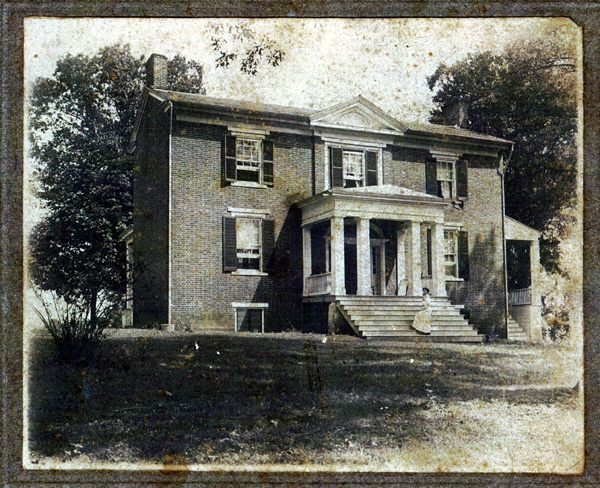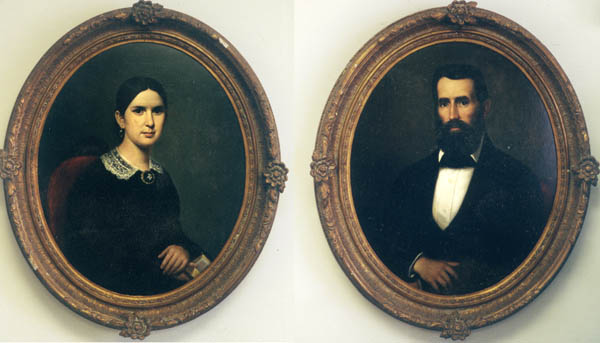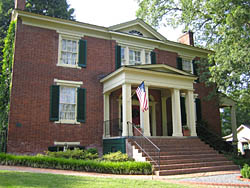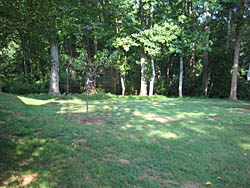

  |
|

|
Name: Cliffside Date: ca. 1915 Image Number: EEcdEE01 Comments: Cliffside sits on a steep hill overlooking Scottsville and was
built in 1835 for Dr. Gilly M. Lewis, a local doctor and owner of Albemarle Mill on the Hardware
River. During the Civil War, Cliffside was the home of the John O. Lewis family and also served as the
headquarters of Generals Philip Sheridan and Armstrong Custer during the Union raid of Scottsville in March 1865.  Sallie Hunt Lewis and her husband, John O. Lewis Later Captain John L. Pitts bought Cliffside for his son, Marion Arthur Pitts, and in the above photo Elizabeth (Holladay) Pitts, his daughter-in-law, is shown standing on the home's front steps. In 1929, Virginia Moore, author of Scottsville on the James, purchased Cliffside and lived there until her death in 1993. 
Cliffside is located on what is now Warren Road, Scottsville. Its original Federal-style structure was rectangular. In front, a flight of steps led to a central hall with up and down stairways on the main story, a dining room on the right (East), and a parlor on the left. Both rooms were large. The ground floor had the same pattern with a kitchen on the right and servants' quarters on the left. The upper story had a central hall and two large bedrooms. All six rooms had fireplaces. Some years after Cliffside was built, it gained an addition behind the right side; its plan was then L-shaped. The addition's ground floor held a laundry, the main floor had a small kitchen and a dining room, and there was a third bedroom above with its own hall and stairs down to the dining room. Each new room had its own fireplace, and it total, there were then nine rooms which all had hand-carved mantels. On August 31, 1929, Virginia Moore, a noted author, bought Cliffside for only $5000 when its previous owner defaulted on his mortgage. Much of the following description of the Cliffside property at the time of Miss Virginia's purchase of it was obtained from John Moore, her son, who compiled the information from her diary and personal notes: "Staying at the Monticello Hotel, I looked for a charming small house, and found several, but they were too expensive. Then someone spoke of a house, Cliffside, twenty miles away, just outside the old river town of Scottsville' less expensive than the best small house I had seen because, at the crash, the owner had lost it for the mortgage. The bank wanted only what it had tied up in it. Would I like to look at it? Why not?" "It was basically an excellent Federal-style brick house over 100 years old. Nine rooms, nine fireplaces with hand-carved mantels each different and in perfect taste. There were three porches, a still older first house (the "Ginger House"), and 14 acres. But in what dreadful condition! I stood in the parlor amid stacks of old magazines festooned with spiders, and my heart said, 'Yes!' " "Violet Cheverton -- friend and helper, not nurse now-- told me she would help bring the old place around. In house and yard, we healed the ravages of time and neglect." "Mother, who knew Georgian and Federal antiques, had taught me; and, having signed a contract for the house, I began to haunt antique stores and auctions. I had a sofa now, and chairs, and beds, and a really stunning secretary."

Nearby the Ginger House is a small Lewis family cemetery. When Virginia Moore built her pool up the hill from this plot in the 1970's, the headstones were moved to the Scottsville Cemetery although the bodies were not exhumed. The graves remain and are unmarked. The photo at left shows the Lewis family graveyard on Cliffside property as it appears today with unmarked graves. According to a Virginia W.P.A. Historical Inventory Report, dated November 10, 1936, the cemetery contained several unmarked graves as well as two grave stones bearing the following names and dates: On the first stone:
John Owen Lewis
Born 1814-Died 1890 Sallie Hunt Lewis, Wife of John
Born Aug. 30, 1835-Died March 1st, 1909 Clara Edmunds Lewis, Daughter
Born 1873-Died Jan. 19th, 1903 Parents and Grandparents of the above:
Charles Richardson Hunt
Born Oct. 14th, 1805-Died Dec. 12th, 1883 Cora Barksdale Hunt
Born 1813-Died Jan. 19th, 1877 On the second stone:
Adolphus Perkins Bowles, M.D.
July 2, 1870-Nov. 27, 1903
Miss Virginia, as she was called, made many improvements at Cliffside. The antiquated and dangerous electric wiring, which had two separate wires with rotting cloth insulation, carried around the house several inches apart on ceramic stand-offs, was replaced. The ground-floor rooms were closed in and finished, adding a hot-air oil furnace on the right and a sitting-room with a piano on the left. The parlor on the left of the main floor was redecorated, and the room on the right gained three walls of shelves for her many books. In a later stage compled in late 1940's, a new brick two-story garage, designed to match the original architecture, replaced the original wooden garage. The stairs from the third bedroom to the new dining room were eliminated, allowing the latter to become grander. Instead, new stairs led down from that bedroom to the small kitchen, which then became a pantry. A new large kitchen, breakfast area, spare bedroom, and bath were built above the garage. At about that time, the Ginger House was enlarged. The top photo of Elizabeth Holladay Pitts at Cliffside is from the Eleanor Evans collection. Eleanor resides in Suffolk, Virginia, and is the granddaughter of Lucy Mason Holladay and her husband, Archibald Douglas Kincaid, and the grandniece of Elizabeth Holladay Pitts. The Cliffside cemetery information is part of the Historical Inventory Report by R.E. Hannum for the Works Progress Administration of Virginia; Record No. VHIR/11/0113 applies at the Library of Virginia, Richmond, Virginia. The remaining photos were taken in 2008 by Sarah Brummett for Scottsville Museum with permission from James and Diana Svetich of Scottsville, VA. Copyright © 2018 by Scottsville Museum |
|
|
|
Museum
Archive
Business
Cemeteries
Church
Events
Floods
For Kids
Homes
Portraits
Postcards
School
Transportation
Civil War WWII Esmont Search Policy |
||||
|
Scottsville Museum · 290 Main Street · Scottsville, Virginia 24590 · 434-286-2247 www.avenue.org/smuseum · [email protected] Copyright © 2018 by Scottsville Museum |
||||